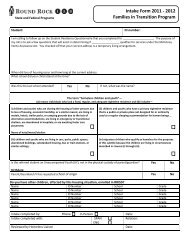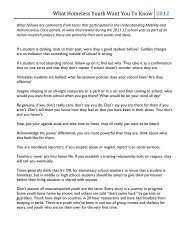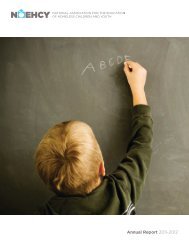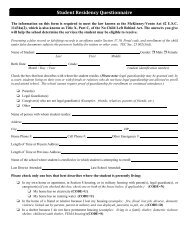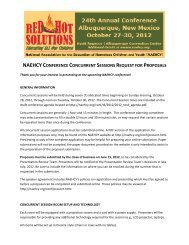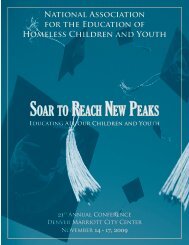The McKinney-Vento Act and Children and Youth ... - State of Michigan
The McKinney-Vento Act and Children and Youth ... - State of Michigan
The McKinney-Vento Act and Children and Youth ... - State of Michigan
Create successful ePaper yourself
Turn your PDF publications into a flip-book with our unique Google optimized e-Paper software.
ENSURING REGULAR INTERAGENCY CONTACT<br />
• Implement a practice <strong>of</strong> automatically informing counterparts <strong>of</strong> changes in<br />
school or child welfare policies immediately, via email or fax. This will help<br />
ensure that the other agency can be prepared to adjust to the new policy<br />
<strong>and</strong> respond quickly <strong>and</strong> seamlessly for youth.<br />
Offer ongoing training<br />
opportunities to help each<br />
agency underst<strong>and</strong> the<br />
policies, practices, <strong>and</strong><br />
priorities <strong>of</strong> the other.<br />
• Establish regular meetings between child welfare <strong>and</strong> education staff to update<br />
contacts, discuss new policies, <strong>and</strong> develop new practices to meet emerging<br />
challenges. For example, the Office <strong>of</strong> <strong>Children</strong>’s Services in Anchorage<br />
hosts the Greater Anchorage Area Partnership (GAAP) as a forum for<br />
communication <strong>and</strong> collaboration for a variety <strong>of</strong> agencies serving youth<br />
in out-<strong>of</strong>-home care. GAAP’s monthly meetings nurture the collaboration<br />
between the school system <strong>and</strong> the child welfare agency <strong>and</strong> provide a<br />
reliable, consistent forum to address challenges.<br />
• Designate staff positions that will be responsible for ongoing communication<br />
between schools <strong>and</strong> the child welfare agency. For example, Delaware has<br />
drafted a state-level Memor<strong>and</strong>um <strong>of</strong> Underst<strong>and</strong>ing that states:<br />
“In addition, DOE, LEA <strong>and</strong> Charter Schools, <strong>and</strong> DSCYF<br />
(divisional representation in all counties) will designate liaisons to<br />
support effective communication <strong>and</strong> implementation <strong>of</strong> the MOU,<br />
as well as to mediate conflict to successful resolution.”<br />
“ For a long time, the Office <strong>of</strong> <strong>Children</strong>’s Services didn’t prioritize education because<br />
they were so focused on basic safety. We are trying to help them underst<strong>and</strong> that school<br />
stability helps with placement stability. <strong>Youth</strong> who are happy at school will be happier<br />
at home.”<br />
— Barb Dexter 40<br />
Educators <strong>and</strong> child welfare workers have different specialties <strong>and</strong> training. If<br />
each group shares with the other their expertise about how to support youth<br />
in care, both groups will be better equipped to serve youth. Particularly, both<br />
agencies need to share the same underst<strong>and</strong>ing about the legal requirements<br />
<strong>of</strong> the <strong>McKinney</strong>-<strong>Vento</strong> <strong>Act</strong>.<br />
Alumni from foster care are also a critical resource to help both educators <strong>and</strong><br />
child welfare staff underst<strong>and</strong> the realities <strong>of</strong> life in out-<strong>of</strong>-home care. Many<br />
states <strong>and</strong> local areas have active groups <strong>of</strong> such alumni who are willing to<br />
speak to school staff about their experiences <strong>and</strong> the importance <strong>of</strong> school<br />
Strategies for Improving Educational Outcomes through School Stability 23




